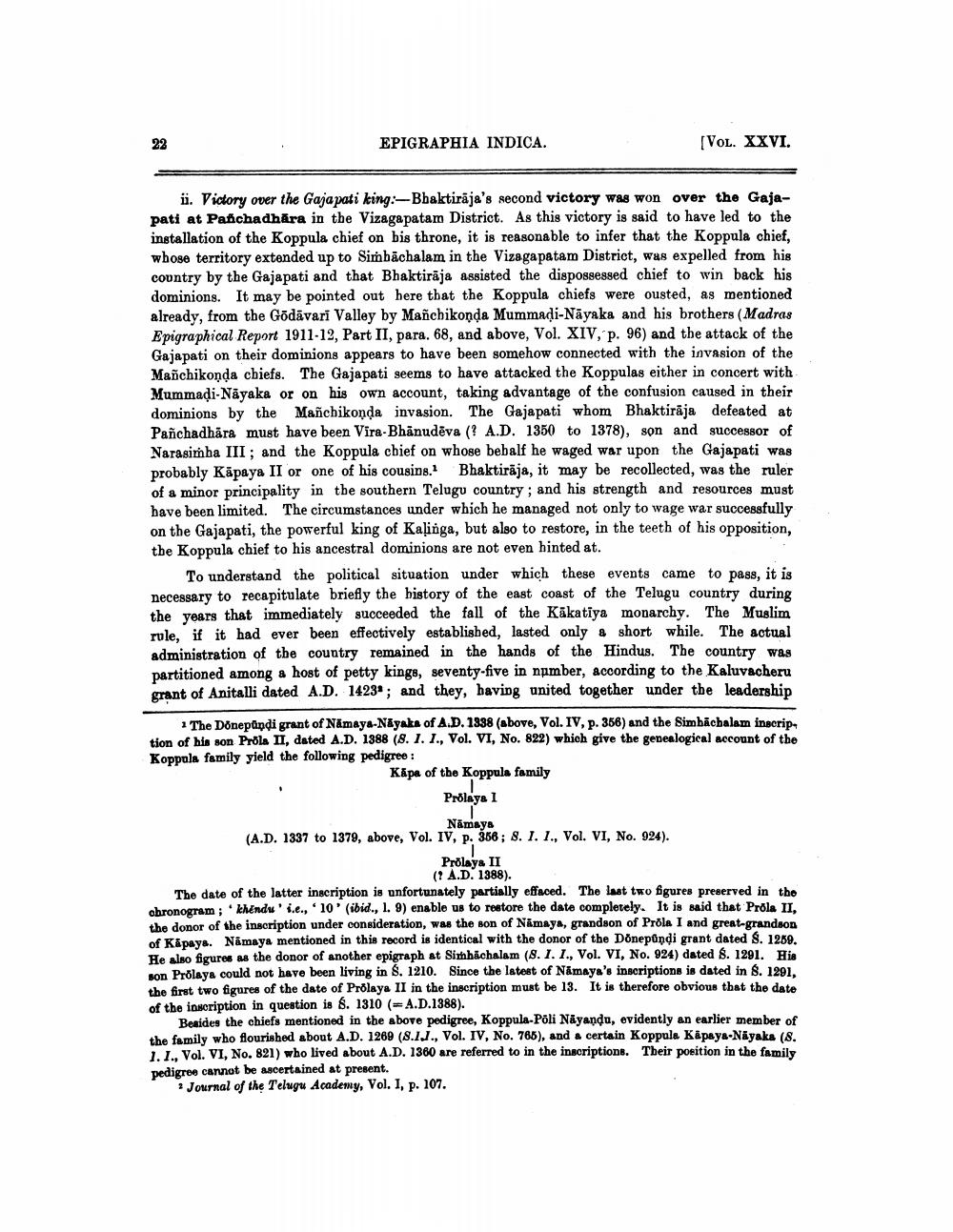________________
EPIGRAPHIA INDICA.
(VOL. XXVI.
i. Victory over the Gajapati king:- Bhaktirāja's second victory was won over the Gajapati at Panchadhara in the Vizagapatam District. As this victory is said to have led to the installation of the Koppula chief on bis throne, it is reasonable to infer that the Koppula chief, whose territory extended up to Simbachalam in the Vizagapatam District, was expelled from his country by the Gajapati and that Bhaktirāja assisted the dispossessed chief to win back his dominions. It may be pointed out here that the Koppula chiefs were ousted, as mentioned already, from the Godavari Valley by Mañchikonda Mummadi-Nāyaka and his brothers (Madras Epigraphical Report 1911-12, Part II, para. 68, and above, Vol. XIV, p. 96) and the attack of the Gajapati on their dominions appears to have been somehow connected with the invasion of the Mañchikonda chiefs. The Gajapati seems to have attacked the Koppulas either in concert with Mummadi-Nayaka or on his own account, taking advantage of the confusion caused in their dominions by the Mañchikonda invasion. The Gajapati whom Bhaktiraja defeated at Pañchadhāra must have been Vira-Bhanudēva (? A.D. 1350 to 1378), son and successor of Narasimha III ; and the Koppula chief on whose bebalf he waged war upon the Gajapati was probably Käpaya II or one of his cousins. Bhaktirāja, it may be recollected, was the ruler of a minor principality in the southern Telugu country; and his strength and resources must have been limited. The circumstances under which he managed not only to wage war successfully on the Gajapati, the powerful king of Kalinga, but also to restore, in the teeth of his opposition, the Koppula chief to his ancestral dominions are not even hinted at.
To understand the political situation under which these events came to pass, it is necessary to recapitulate briefly the history of the east coast of the Telugu country during the years that immediately succeeded the fall of the Kakatiya monarchy. The Muslim rule, if it had ever been effectively established, lasted only & short while. The actual administration of the country remained in the hands of the Hindus. The country was partitioned among a host of petty kings, seventy-five in number, according to the Kaluvacheru grant of Anitalli dated A.D. 14234; and they, having united together under the leadership
1 The Donepündi grant of Namaya-Nayaka of A.D. 1338 (above, Vol. IV, p. 356) and the Simbachalam inscrip tion of his son Prola II, dated A.D. 1388 (8. 1. I., Vol. VI, No. 822) which give the genealogical account of the Koppula family yield the following pedigree:
Kāpa of the Koppula family
Prðleys 1
Nāmays (A.D. 1337 to 1379, above, Vol. IV, p. 356; 8. 1. 1., Vol. VI, No. 924).
Prilaya II
(? A.D. 1388). The date of the latter inscription is unfortunately partially effaced. The last two figures preserved in the ohronogram ; khendu i.e., '10' (ibid., 1. 9) enable us to restore the date completely. It is said that Prola II. the donor of the inscription under consideration, was the son of Námaya, grandson of Prola I and great-grandson of Kapaya. Namaya mentioned in this record is identical with the donor of the Dönepondi grant dated 8. 1269. He slao figures as the donor of another epigraph at Simhachalam (8. I. I., Vol. VI, No. 924) dated 8. 1291. His son Prðlaya could not have been living in 8. 1210. Since the latest of Namaya's inscriptions is dated in 8. 1291. the first two figures of the date of Prolaya II in the inscription must be 13. It is therefore obvious that the date of the inscription in question is 6. 1310 (=A.D.1388).
Besides the chiefs mentioned in the above pedigree, Koppula-Poli Näyandu, evidently an earlier member of the family who flourished about A.D. 1269 (8.12., Vol. IV, No. 765), and a certain Koppula Kapaya-Nayaka (8. I . Vol. VI. No. 821) who lived about A.D. 1360 are referred to in the inscriptions. Their poeition in the family pedigree cannot be ascertained at present.
* Journal of the Telugu Academy, Vol. I, p. 107.




